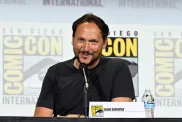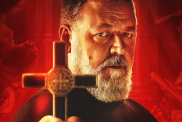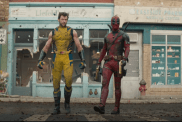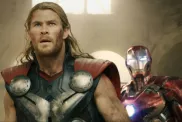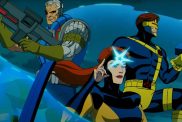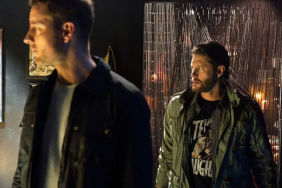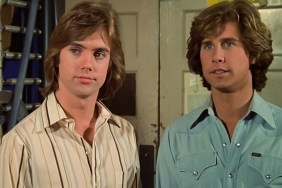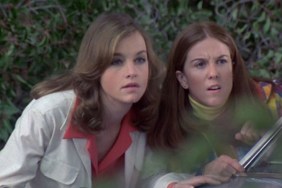Filmmaker on creating on-line frights!

If you’ve ever searched the Internet for quality web-based horror entertainment, then hopefully you’ve stumbled upon the short films from the filmmaking collective known as Fewdio, a group that’s accumulated close to 50 original horror shorts on-line. At the forefront of a lot of those shorts is writer/director Drew Daywalt, a filmmaker and die-hard genre fan that wears his love of horror on his sleeve.
Just on the cusp of two feature length projects, as well as branching off with his new horror banner Daywalt Fear Factory, Shock got to chat exclusively with Daywalt about the history of Fewdio, the origins of some of their most popular shorts, his upcoming web-series Camera Obscura and the key to creating a successful on-line scare in three minutes or less.
Robg.: What was the beginning of Fewdio? What was the driving force that got you guys together to do specifically horror shorts for the web?
Drew Daywalt: We all came from comedy and big action studio films, and one of our members John Crye came from Newmarket Films and he was on the heels of doing Memento and Stark Raving Mad, Donnie Darko, Whale Rider, The Prestige. He just wanted to do something that was free form, and we all wanted to do something that we had complete creative control over, because we had been working in the studio system, all of us for at least 10 years as actors, writers, directors, producers, etc. At first, we thought “do we do comedy?” We saw that there were already some great people out there doing comedy. The web doesnât need more comedy, because for starters youâre competing with things like “cat plays piano” but on the other end of the spectrum youâve got great comedy troupes out there too. We went to look at horror, which I myself grew up with. My brother collected things like Creepy, Eerie and Weird Tales. I discovered Lovecraft by the time I was 8. Flash forward to 2007-2008, I said “Letâs do horror.” Iâve never really had the chance to do genre stuff with the studios because they pigeonhole you. You do comedy stuff? Then youâre doing comedies. We went to look on line and there was no substantial body of horror from anybody. There was no horror troupe the way there are comedy troupes. So we decided to be a horror troupe. We knew the model from the comedy troupes. You get a writing pit, you bring forth your best stuff, you pick the films youâre going to do and you shoot it. It was a niche that wasnât being filled on line and we all loved it.
Robg.: You figured if the comedy troupes can do one joke or skit in between two to five minutes, why couldnât you guys do one scare?
Drew: Yeah, exactly. You end on a scare and bang, youâre out. And itâs a good model to aspire to. Twilight Zone is formulated that way. Set up, continued set up, expected left turn, roll credits. Itâs the same with a joke or even a magic trick. The formulaâs kind of the same. So we thought letâs try it with horror. Everyone thought we were out of our minds. Like, you canât scare people without the slow build. I always point back to the original The Haunting from 1963. Thereâs a scene where sheâs laying in the bed and weâre not sure if sheâs mentally unstable or perhaps sensitive in a psychic way. You hear something coming down the hall, and youâre staring at that door knob for like 45 seconds and it always gets me. That made me think, well yeah, there was 35-40 minutes before that in the film that led into that moment, but we can cut in on the “Did you hear that?” and itâs still scary, good tension. We figured if we could formulate our first few like that in three minutes, theyâd be great. Our first shorts were actually 10 minutes long. We quickly learned that those are just too long. I myself am guilty of passing on something thatâs that long. Take any good three minutes sequence out of a good horror film, and it could stand alone as its own great short, in the same way that you can take a four to five minute gag out of a comedy film and itâs its own short film. One of the funniest Iâve seen on line is The Easter Bunny Hates You and itâs hilarious. One of the first oneâs we released was The Easter Bunnyâs Eating My Candy, which we released on Easter hoping that the tag “Easter” would get it attention and it really worked because we had 50,000 hits in a week. It was just good timing! Fewdio has over 30 videos, plus the web-series Camera Obscura is 20 episodes. So personally Iâve clocked in 50-60 of these things!
Robg.: Obviously, there are different names in the credits in terms of who directs each short. So how does the creative process work? Do you guys have round table meetings to discuss whoâs going to do what for which short?
Drew: In the beginning, it was a round table thing. Then it became apparent as we were producing them that people fulfilled different roles of production. John Crye and Kirk Woller for instance, theyâre great actors. Kirk has made a great living as a character actor. Some of the guys like to act more, although John and Kirk did direct one short each, both of which were well received. Dave Schneider and I, along with Paul Hungerford eventually became the core creative side of things because we found ourselves gravitating towards new ideas. Weâd show up to meetings that had nothing to do with the creative side and have a new script in hand. There was a division where some of us handled the business side which included the marketing and Dave, Paul and I just enjoyed making the films. It was a very loose process.
Robg.: I really love Bedfellows, which seems to be a popular oneâ¦
Drew: Itâs like our hit single! [Laughs]
Robg.: Whereâd the idea for that one come from?

Drew: Bedfellows came about right around the summer of 2008. The guys wanted to break from making new content for a while so we could catalog what we had made and make a DVD. In my opinion, I personally wanted to keep creating content. We decided if itâs three or more of the Fewdio crew working on it, itâs a Fewdio project. If itâs just me doing my own thing with actors I find and my own production, then itâd be under my own banner which is how I introduced Daywalt Fear Factory. So there were a bunch of films that we started in 2008 and 2009 that I just made on my own completely and submitted to the guys. Bedfellows itself was actually honest to God my own personal embodiment of the boogeyman. I swear that was⦠everybody has an idea of when you close your eyes and think back to when you were a child what the boogeyman looks like to you. That was the face I was convinced the boogeyman had. I looked at him in Bedfellows and he really creeped me out on set. Normally I donât get creeped out, but he did it. Heâs a cross between Captain Howdy (from The Exorcist) and Nosferatu, and those two scared the shit out of me! Thereâs something about that blank face. Thatâs why Michael Myers and Jason Voorhees work is because of the blank face. You donât get anything back when you look at those faces, itâs the broken sociopath.
Robg.: One of the recent ones I really liked was Suicide Girl, mainly because of how timely it is, both in content and using the internet to your advantage for that story. The fact that kids are really that mean to each other these days is really scary to me. What inspired that particular one? Because a lot of them seem to stem from real life news.
Drew: Yeah, it does. Itâs part of my warped mind. I will read the news and think of how to make it into a horror film. A lot of these come from the news. Do you remember that story about that woman and her daughter who tortured this poor girl on My Space? That made me sick. And I understood because I was totally the butt end of those jokes when I was in high school. So I related to that poor girl, and to think she was driven to suicide not just by a shitty asshole teenager, but that shitty asshole teenagerâs mom as well. So, putting that into the horror context and going with the Japanese vengeful ghost model, I thought ⦠letâs kill âem! Itâs a plain old fashioned revenge film, where you can plug yourself in if you were the kid that was picked on by the popular kids or shit on by the social controllers of the high school or in college, and wouldnât it be great to hang those two assholes?
Robg.: Are there any shorts that stand out as your favorites amongst the bunch?
Drew: Bedfellows rings true to me. I really enjoyed Door 17. The actor in that one Edin Gali, this was his first job. It turned out he was a Bosnia war refuge and he said, “what if I scream in Bosnia?” You know what? Just do it. The look of it had a seedy European feel to it anyways, so we thought it could be anywhere. Then when we were cutting it, we discovered you donât need to subtitle someone screaming for their life, because you get it, so we didnât even subtitle it. When the door opens and thereâs this Cthulu/Shaggoth-like creature pleasuring itself to his misery, it was just so darned dark! Itâs as hideous as it gets! Thatâs a favorite for me.
Robg.: The one I liked a lot that I thought was really cool, but not really clear at first was Viral.
Drew: Oh yes, Viral. Thatâs my Ishtar! [Laughs]
Robg.: Itâs a great idea! The idea of staring at this creepy guy in a photo and it makes you go crazy and kill everyoneâ¦
Drew: Itâs a brilliant concept. That started when I found this photo on line, this creepy murderer with this woman sitting beside him. Itâs an early 50âs picture, and she looks so scared in it. The guy was a strange looking guy, the way Lovecraft wouldâve described a creepy physician. I sent it around to the Fewdio guys, and I asked who could come up with the greatest ghost story to go with this photo. Everyone pitched in. And John Crye writes this thing and it was oblique. We cleaned it up and John and I co-directed that one. And⦠we just didnât get it right!
Robg.: Well, despite it not being totally clear, I got it. I like the idea of staring at this picture of this creepy guy and it driving you mad. Now one thatâs very simple that I got a kick out of was Ninja Clown Monster.

Drew: Oh, Ninja Clown Monsterâs great! Actually, Paul Hungerford wrote that after I sent him “Ninja Cat”. Have you seen that video on-line? Itâs this guy looking at his cat down the hallway, and heâd go behind his desk and when he came back itâd be in a different position. The cat was perfect! We just thought “wouldnât it be great if it was a monster instead of a cat?” So Paul wrote it, heâs actually the clown in it. I went to Michaelâs Craft store and bought a scarecrow doll, took the hair off and painted it into a clown doll, painted it white and gave him creepy eyes. We make all our own props which is half the fun. That oneâs simple. Thereâs no real story. Sometimes itâs just a scare! Sometimes in EC Comics, or even Night Gallery, theyâd throw in two minute job for filler, no story.
Robg.: I came and visited you while you were shooting Poly Deus. Iâd never heard this urban legend about this video game. What was the story behind that?
Drew: Yes, Polybius was the game. Itâs an urban legend about a video game from 1981 where they had a game that showed up in four out of the way arcades in the suburbs of Portland, Oregon. This stand-up arcade game called Polybius with vector graphics, like Tempest or Asteroids. The kids who played it were suffering from nightmares, post-traumatic stress disorder, panic attacks, visions, hallucinations and insomnia. Basically all the different forms of dementia that you get when youâre old. Some kids passed out, some suffered from migraines for the rest of their lives. And four days later, all four arcade games were taken away by guys in black vans. Itâs an awesome urban myth. You can go to You Tube where people have created mods for it, for what it might have looked like to give you hypnosis. People have even gone as far to make fake video game box art for it.

It intrigued me because itâs retro, I love video games and I love creepy urban myths, and Iâm doing shorts now, so I thought Iâd do one based on this. Some company has picked up the rights to the name so I canât use the name, so I call it Poly Deus which plays on the plot. In our story, we open on a guy in his apartment, sleeping, itâs 4 in the morning and his friend comes bursting in and panicking, because heâs just played the first level of Polydeus. The friend asks, “well how did you get it?” And he replies, “My brotherâs a guard at Guantanamo Bay and itâs in the prisoner rec room, just for the prisonerâs. The guards arenât even supposed to look at it. Well, he played it and copied his rom onto this disc.” So the brother played it and went into a catatonic state. And now the friend says, “Iâm not doing so well. I think thereâs creatures following me.” He bolts out of the apartment. And on his way out, he drops the CD-ROM, our hero finds it, plays it, and⦠well youâll have to see the short for the rest!
Robg.: How long does it usually take you to do the average short?
Drew: It depends. In the FEWDIO days, we did a little more delegation. It was like a comedy troupe where you pick the way youâre going to do it, so it took a little longer to organize. But now since Daywalt Fear Factory, with Suicide Girl and Thereâs No Such Thing and Bedfellows, those took a week to write, put it together in my head, put together a 4-5 page script. I try to write it for a budget. So roughly it takes a week to put all together and find good actors. One of the things weâve been praised for is finding good actors.
Robg.: Acting is key.
Drew: Thereâs lots of good actors out there. And itâs all about getting the right actors. Weâre now using the same 30 or 40 actors we rotate around, so it makes for its own world and continuity. I continue to work with the same actors. In fact, Edin Gali who did Door 17 with me two years ago, heâs going to do a feature with me, a ghost story called The Call. Heâs the lead of it. He plays a cop whoâs a 911 operator and he fucks it up. Every body in the situation dies at the house including his niece because he makes a mistake in dealing with the call. Heâs dismissed from the force and now every night at 8:55PM when the first call came in, he gets the 911 call. When he leaves the police station, the 911 call comes to his cell phone. When he gets home, it comes to his home. When he unplugs all his phones, they still ring and thereâs the 911 call. So he has to solve the mystery of what happened that night. Each time he answers, he starts taking notes and asking different questions. Weâll be doing that feature this summer. Edin Gali, right after Door 17, he took that short for his audition on Mad Men and became a regular on that. Phenomenal actor, we just happened to find him first.
Robg.: What can you tell us about your upcoming web-series Camera Obscura?
Drew: MWG Entertainment and Max Goldenson and Robert Kandle, the two producers there, really put their faith in me to do a whole web series. They wanted to do something edgy for a web-series. They did two really good web series and they got product placement in them and were able to put them out there with some success. What happened with Camera Obscura, because its horror, we didnât get as much product placement in there, and their model had changed to “if we make it good enough, we can sell this thing.” It was supposed to air last October for Halloween, but when they started seeing the episodes around August-September, to my glee they wanted more. The plan changed for more episodes and to find a good home for it. Itâs 20 episodes. Itâs about 85-90 minutes long and itâs like a feature. We should have a new teaser up soon, as well as details on how you can see it soon.
Robg.: Tell me about Daywalt Fear Factory and why youâve parted ways with Fewdio?
Drew: Well, first of all, itâs a very amicable thing. Three of the five principles of Fewdio were at my wedding, so these are dear, dear friends of mine. The idea of Fewdio was to help it to launch all of us collectively and individually because we all respected each otherâs careers. When I got the offer to write and direct Camera Obscura outside of Fewdio, they were very supportive and thought it was great. Each of them has continued with their own projects and itâs been like a collective more then a company. Because of the economy, everyoneâs focusing on their own work. I just decided Iâm going to keep making these shorts, and I got offered the chance to do these two features this year so Iâm going to do that. Daywalt Fear Factory is just my desire to constantly be making these films, making new contacts in the horror community and giving people chances. I enjoy it so much. Itâs no different then a feature shoot. We do âem in about 6 hours and we keep them contained. Itâs like a poker night for us, or a movie night. Instead of doing a Freddy Krueger marathon, we get together and make something. That personal hobbyist approach is one of the reasons Iâm going to continue with Daywalt Fear Factory. And also Iâll continue to support Fewdio in every possible way.
You can visit the official FEWDIO website right here and watch all their horror shorts at this link. Bookmark Daywalt Fear Factory’s page right here. Read Drew’s blog on FearNET at this link.




Source: Rob G.
